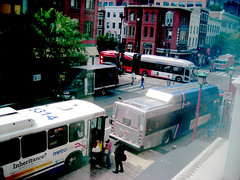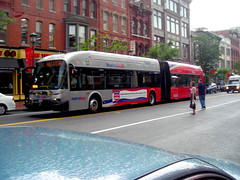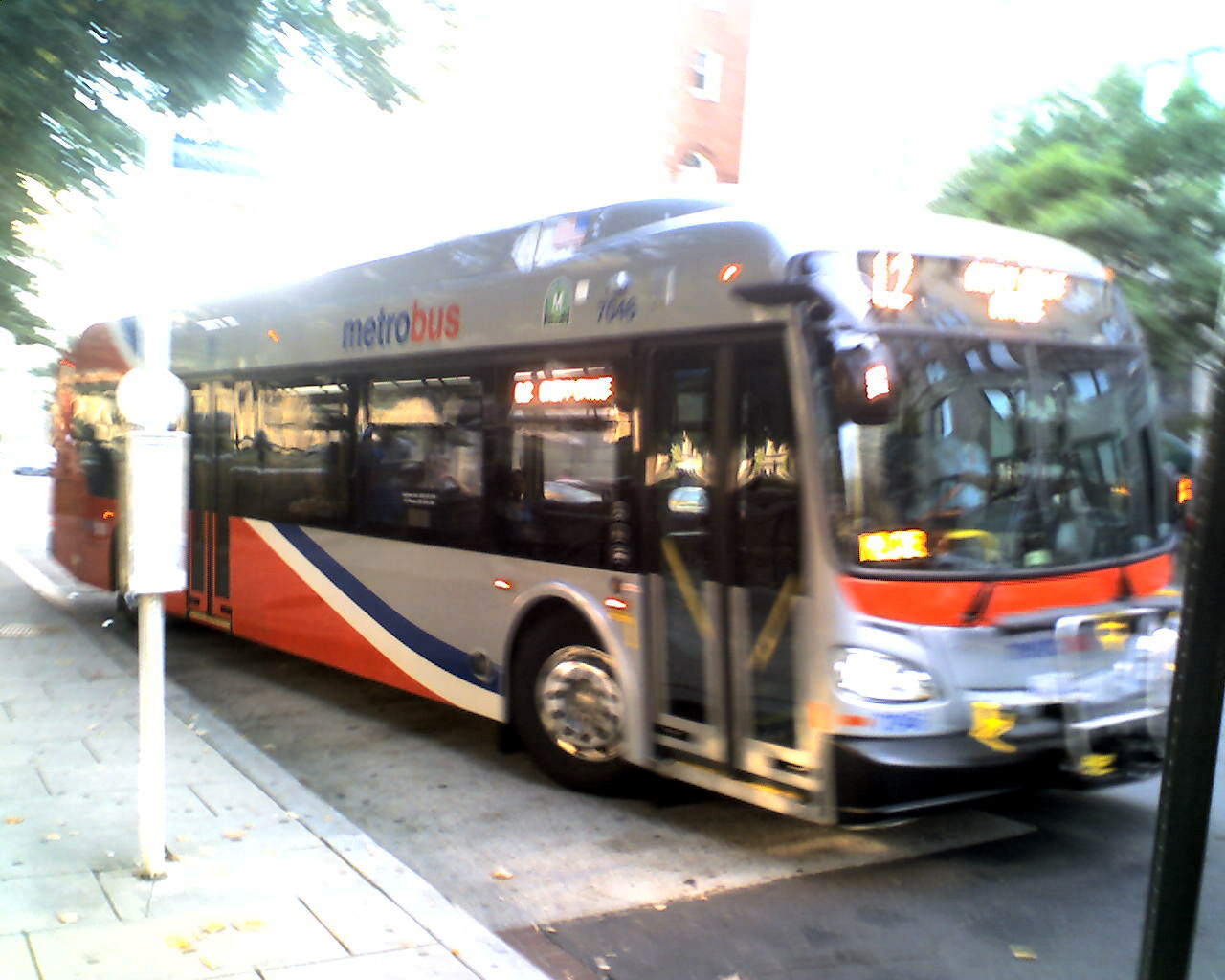|
Special Features





Image Libraries


|
|
Blog
|
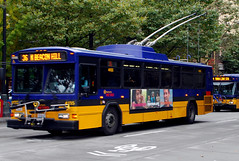
Trolleybus in Seattle. |
Trolleybuses are rubber-wheeled buses that are powered by overhead wires. They offer a number of advantages over regular buses, but are very rare in the United States.
There are currently only five US cities that operate trolleybuses. They are Boston, Philadelphia, San Francisco, Seattle, and Dayton. Trolleybuses are so rare because they require overhead wires, which are expensive to install, limit bus route flexibility, and are often considered ugly.
On the other hand, compared to normal diesel buses, trolleybuses are quieter, smoother, cleaner, and accelerate faster. They also offer a sense of permanence that normal buses can’t match.
Many of the advantages of trolleybuses come from their power source. Since they run on electricity rather than fossil fuels they emit no fumes, and they accelerate quickly, smoothly, and quietly. However, all those advantages can be duplicated by wire-free electric buses without the cost or trouble of overhead wires.
So why bother with wires?
Because the cost and relative rarity of wires is a sure signal that a transit route will be predictable and permanent. Wires provide the same sort of visual fortification that rail tracks provide. They are a clear signal to riders that they are dealing with a significant and special transit line.
Since so few trolleybuses have been built in recent years, and all the cities that use them have used them for decades, it is difficult to know how much of an effect wires without tracks can have on transit oriented development. Given the push for affordable BRT in many cities, the potential prospect of TOD-inducing buses is something that ought to be explored.
|

Trolleybuses can shift lanes without disconnecting their wires. |
Trolleybuses even offer a significant advantage over rail streetcars. Since they aren’t tied to tracks, flexible trolley poles allow buses to switch lanes in order to go around obstructions. Without tracks to constrain them, trolleybuses mixing in a lane with cars are less likely to be held up by traffic. Additionally, many trolleybuses are built as hybrids and are capable of lowering their poles and running on batteries or fossil fuels as a backup.
It is unfortunate that the so few trolleybus systems survived the 20th Century. Most of them fell victim to the same transit death spiral that destroyed most American streetcar systems.
However, streetcars are enjoying a renaissance because contemporary planners have discovered they can be useful. It may be time for trolleybuses to enjoy a renaissance of their own.
Average Rating: 5 out of 5 based on 297 user reviews.
November 14th, 2011 | Permalink
Tags: bus, transportation

Hello again, blogosphere. I’m now married, honeymoon-ed, and attempting to get back into the swing of things. Since I’ve spent the last two weeks on a planner-geek trip exploring the Pacific Northwest, I may as well share a few thoughts from the experience.
I’ll post pictures of the most interesting things after I’ve had a chance to sort through what I took and upload to flickr, but that will take a few days.
Seattle
Seattle is a much larger city than I expected. The central city felt comparable to Philadelphia, rather than the Denver or San Diego scale that I anticipated. It is also more urban, although like most western cities the bulk of its neighborhoods are composed of bungalows rather than rowhouses. Still, most neighborhoods seem to have walkable main street business districts, in the Tenleytown or Takoma Park sense. Downtown Seattle is in great shape, and is fabulously retailed. From a shopping perspective it is better than downtown DC.
Seattle’s major weakness is that it is in dire need of better transit. There is a downtown subway tunnel that buses and light rail trains share that is extremely cool, and very convenient, but outside of downtown the options are limited. The bus system is extensive, but there are too few trunk routes that can be counted on for frequent service. Trolley buses are common, which is cool (a future post will explain why I like them), but overall the system is just not adequate to the needs of a city like Seattle. With a proper transit system Seattle could be the urbanist equal of the big east coast cities, but without one it is stuck in the second tier. The good news is they are building their regional transit network, so the future looks bright. |
Portland
Everyone said that Portland would feel much smaller than Seattle, and indeed it does. Portland reminded me very much of a college town that has grown to become a large city, as opposed to a city that was always destined to be big. Part of that is the scale, but part of it is also the arrangement of land uses. I’ve never before encountered an American city with such good integration of office and residential uses in the core. I would say that downtown Portland blends seamlessly with the surrounding neighborhoods, except I hesitate to even say that Portland has a traditional “downtown”. Rather than an office ghetto surrounded by residential neighborhoods, the entire central city is a mixed-use mass of both office and residential buildings. Portland doesn’t have a downtown; it has a city center. The architecture is American, but the land uses are European.
Portland’s transit is equally impressive. Light rail works there, better than I’ve seen it work anywhere else. Many cities that try to use light rail as if it were commuter rail find that it is inconveniently slow, and lacking in capacity. Portland makes no such mistake. Street-running light rail is perfect for smaller places, and Portland’s scale fits it like a glove. Seattle needs its downtown subway, but smaller Portland feels complete and well-served with its slower surface trains. |
Vancouver
Of the three cities, I had the highest expectations for Vancouver. More than any other North American city in the 21st Century, Vancouver has a reputation for embracing high rise residential infill. I was excited to see it in person.
There are indeed many contemporary high rises, although the central city is not so blanketed with them as I had expected. Many of the high rises are wonderfully designed, and are excellent examples of contemporary architecture. That said, the new skyscraper neighborhoods still don’t have the sidewalk diversity of historic streets. They are better at the ground level than Ballston, but not by much. The best streets in Vancouver were lined by low-rise commercial buildings, which stand in odd contrast to the surrounding high rises.
From a transportation perspective, Vancovuer offers much to like, but also falls short in a number of ways. Its SkyTrain system is by far the highest quality metro in the region, being entirely grade separated and automated. Unfortunately, it barely serves the central peninsula of the city at all. The trans-peninsula route that should be the backbone of the city does not exist, and is sorely missed. And while the bike infrastructure is wonderful and eclipses even Portland in quality and coverage, Vancouver misses many of the small things that Portland does right – things like the width of sidewalks, placement of curb cuts, etceteras. |
Overall, all three cities are good and I am happy to have finally visited them. Vancouver didn’t quite live up to my expectations, but they were probably unrealistically through the roof. I had more meager expectations for Portland, despite its tremendous hype within the planning world, but found that I liked it the best of the three.
Average Rating: 4.4 out of 5 based on 278 user reviews.
November 2nd, 2011 | Permalink
Tags: bike, bus, lightrail, metrorail, transportation, urbandesign

|
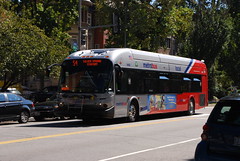
An S4 Metrobus. An S2 is undoubtedly close. |
One of the key advantages of DC Circulator buses over WMATA Metrobuses is how they are scheduled. WMATA will soon adopt a more Circulator-like approach for one of its busiest routes.
Circulator buses don’t have a traditional schedule, they simply try to keep about 10 minutes apart from each other, so that riders never have to wait long for a bus. WMATA buses, on the other hand, try to keep to a timetable, which is often impossible and which inevitably leads to “bus bunching, ” in which multiple buses come at the same time and leave large gaps between them.
As a frequent rider of the S-series Metrobuses on 16th Street, I can say with authority that bus bunching is the rule there, rather than the exception. It’s incredibly frustrating to wait 25 minutes for a bus that is supposed to come every few minutes, and then to have 3 buses roll by all in a row. Incredibly frustrating. And it happens all the time.
The good news – the fantastic news – is that with Circulator’s successful example out there proving how timetable-less, headway-based scheduling can work, WMATA is now willing to make its own experiment with the idea. They will first implement headway scheduling on the 90s series bus routes. Rather than futilely hoping to stick on a timetable, this weekend 90s-series buses will begin to try and remain 7 to 8 minutes away from other 90s-series buses.
I’m sure the experiment will prove successful, and hope WMATA quickly shifts to headway scheduling on other high-frequency bus lines, such as 16th Street, 14th Street, and Georgia Avenue.
Average Rating: 4.5 out of 5 based on 152 user reviews.
September 22nd, 2011 | Permalink
Tags: bus, transportation

I am what you might call a transit nerd. I get my kicks geeking out to new trains and new buses. All the cool kids are doing it, right? Anyway, for bus geekery specifically, the very best place in the DC region to observe a steady stream of diverse and cool buses is the corner of 7th and H Streets, at Gallery Place. Every Metrobus imaginable runs by there, plus the Circulator and a host of others. “Accordion buses” in particular, for which I am a giant sucker, are everywhere.
A few weeks ago I camped out at the corner with a pocket camera for maybe 10 minutes, and snapped these pictures. Enjoy.
Average Rating: 4.4 out of 5 based on 218 user reviews.
September 12th, 2011 | Permalink
Tags: bus, galleries, transportation

I am a fan of wrapping trains and buses in advertisements. It adds color and interest to city life. Here are a couple of creative bus wraps that put WMATA’s old Go Green campaign to shame.

Bus in Copenhagen advertising their zoo. Photo source unknown.

Bus with shark mouth doorway. Photo location and source unknown.
Average Rating: 4.4 out of 5 based on 282 user reviews.
August 12th, 2011 | Permalink
Tags: bus, fun, galleries, transportation

Yesterday, for the first time, I saw one of WMATA’s new “Xcelsior” model buses in the wild. Using my cell phone I snapped a quick picture, which is shown at right. (Here is a better picture, from a manufacturer ad.)
These should become much more common sights over the next few years.
Average Rating: 4.6 out of 5 based on 295 user reviews.
August 10th, 2011 | Permalink
Tags: bus, galleries, transportation

Check out this bus station in Cleveland, courtesy friend ofBeyondDC MPK:

Look familiar? Here’s DC’s version, on New York Avenue:
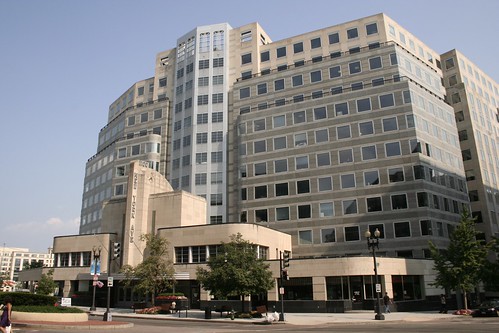
Photo by Elvert Barnes.
I wonder whether Cleveland’s version or DC’s came first, and whether any other cities have one.
Average Rating: 4.9 out of 5 based on 195 user reviews.
August 8th, 2011 | Permalink
Tags: architecture, bus, galleries, intercity, transportation

|
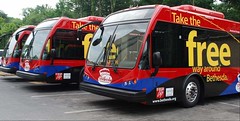
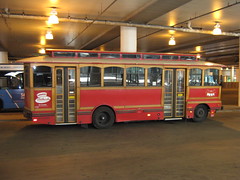
Images by Gazette newspapers (top) and flickr user Pinoy Photographer (bottom). |
The Bethesda Circulator is a free bus shuttle serving downtown Bethesda. For years the service has operated using a fleet of old-timey fake trolleys, but as of this week the kitsch is out. The Circulator has officially taken the trolleys off the street and replaced them with new buses that look more like a modern tram, and bear a strong resemblance to DC Ciculator buses.
The idea behind the old fake trolleys was that more people would use the route if its vehicles were visibly different from a normal bus. That’s generally true. Unfortunately, fake trolleys have a number of negative effects. Their wood panel seats are uncomfortable, their special parts are difficult and expensive to maintain, and worst of all, they send the message that transit is a theme park ride rather than real modern transportation.
The new buses, on the other hand, accomplish the goal of looking special without any of those negative side effects. They’re comfortable, easy to use, and they look like they belong on the street rather than in Disney World. They’re an improvement in every way.
Now if we could just get Alexandria to ditch theirs too.
Average Rating: 5 out of 5 based on 274 user reviews.
July 27th, 2011 | Permalink
Tags: bus, transportation

|
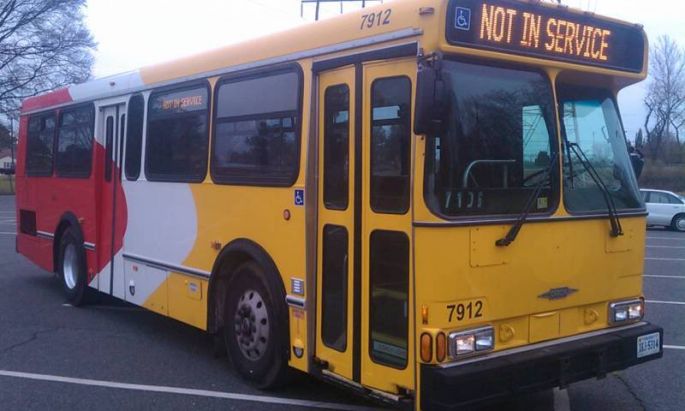
This used Fairfax Connector bus could be yours for $19, 900. |
How much money are you willing to put down to show up all your transit nerd friends? If you’ve got a few thousand dollars to spare you could be the proud owner of a used transit bus, available through resale website BargainBusNews.com.
The transit buses range in price from $9, 500 (for a 1994 35-footer with half a million miles on its engine) to $510, 000 (for a 2010 BRT model that appears new). There are decades-old antiques available, school buses, double-deckers, coaches, faux trolleys, paratransit vans, just about any kind of bus imaginable.
I know what I want for Christmas.
Average Rating: 4.4 out of 5 based on 201 user reviews.
July 11th, 2011 | Permalink
Tags: bus, fun, transportation

|
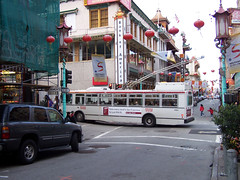
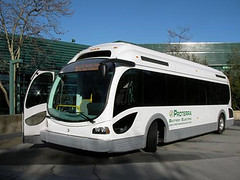
Above: A traditional electric trolley bus in San Francisco.
Below: GM’s wireless electric bus prototype. |
Electric buses offer many advantages over traditional fossil fuel buses, but they are more expensive and difficult to run. A new model by General Motors may bring them to the mainstream.
The most obvious advantage of electric buses is environmental, but the fact that they don’t spew any harmful gases into the atmosphere is hardly the only benefit. Electric buses are also quieter and smoother to ride than fossil fuel buses, resulting in a more comfortable experience for riders and fewer negative effects to the neighborhoods buses travel through.
Traditionally to run an all electric bus a transit agency had to install overhead wires. This can actually be an advantage as well, since it displays a sense of permanence to the transit line, which gives trolley buses some of the same economic development advantages of actual trolleys. On the other hand, wires can also be a big negative, both visually and fiscally. Installing and maintaining overhead wires adds so much to the cost of running a transit line that very few cities in the US use them.
But what if it were possible to run an electric bus without the wires? You’d lose that permanence advantage, but the environmental, comfort, and noise advantages would all still apply. And if, after all, wireless streetcars are being developed, why shouldn’t a wireless bus be possible too?
It turns out General Motors is working on one, along with a company called Proterra. Their EcoRide BE-35 model bus is fully electric and runs on lithium-ion battery packs that give it a 40-mile range for every 10-minute charge. The 35-foot, low floor bus design is basically comparable to normal city buses otherwise.
The website doesn’t include details such as whether the bus can run air conditioning (certainly a requirement in a muggy place like Washington), but if they can make the idea work it has potential to revolutionize urban busing.
 Cross-posted at Greater Greater Washington. Cross-posted at Greater Greater Washington.
Average Rating: 4.6 out of 5 based on 158 user reviews.
June 17th, 2011 | Permalink
Tags: bus, energy, environment, transportation

|
Media





Site
About BeyondDC
Archive 2003-06
Contact
Category Tags:
Partners
|













